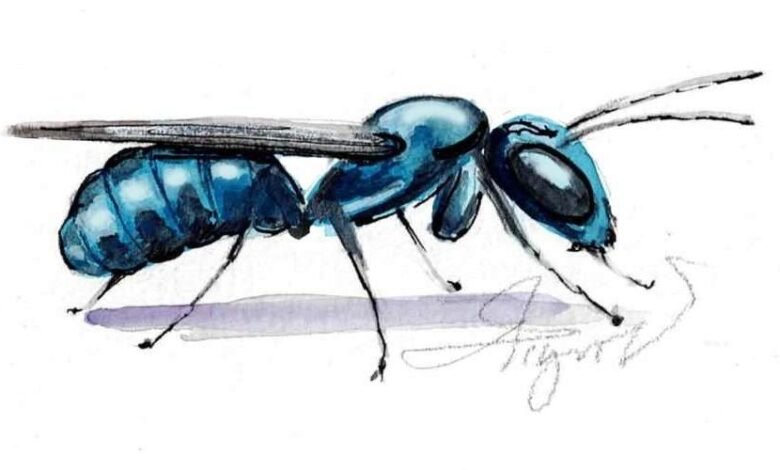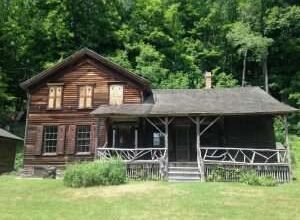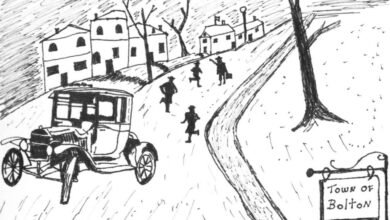Bees at Home in Holes and Hollows During Winter


 On a subzero morning, I clip into skis and head out across my meadow, gliding between desiccated husks of sundial lupine (Lupinus perennis) poking up above the snow.
On a subzero morning, I clip into skis and head out across my meadow, gliding between desiccated husks of sundial lupine (Lupinus perennis) poking up above the snow.
I imagine this spot eight months ago, as I watched bumblebees, mason bees, and sweat bees forage among them. Back then, in June, the world was exploding with sounds and colors, insects on the wing, and birdsong in the humid air. Today, there is silence.
As a pollination ecologist, I spend much of my time chasing solar-powered creatures, crouched among wildflowers observing an intimate interaction between two of life’s kingdoms. The common denominator of it all is sunlight, which provides plants with energy to grow and produce the nectar and pollen necessary for powering the flight of tiny creatures redistributing energy throughout the ecosystem.
But now, in the depths of winter, sunlight is scarce, and the hum of insects will be absent from the landscape until the first willows bloom. The creatures I spend so much time thinking about are gone for half the year. Yet, they haven’t truly disappeared – the progeny of those bees I observed among the lupine are likely nearby, awaiting the return of the sun.
Signs of overwintering bees can be found almost anywhere, with the exception of the European honeybee (Apis mellifera). Having evolved in the tropics, honeybees never experienced selection pressures resembling a Northeast winter. Instead of hibernating, they huddle together in the hive, sipping honey and generating warmth by movement. They emerge during thaws, searching in vain for floral rewards.
Our native bees, on the other hand, are well-adapted to winter and rely on environmental cues to time their emergence. Most solitary bees complete their larval stage and pupate during the growing season before entering diapause, a state of arrested development. They overwinter as pupae, resuming development when their preferred food blooms. Less commonly, some species overwinter as larvae or, in rare cases, as fully developed adults.
Whatever stage of life they overwinter, bees must remain protected from predators, extreme temperatures, and desiccation. About 70 percent of solitary bees overwinter in nests below ground. The rest are scattered throughout the landscape, tucked into stems, logs, rocks, and snags.
Perhaps the easiest above-ground nests to observe are those of the genus Ceratina. These small, turquoise carpenter bees hollow out the pithy interior of dead branches on sumac, elderberry, or raspberry. Find a broken stem on any of these shrubs, and you’ll likely see a small entrance hole where pupae are hidden.
Artificial “bee houses” and natural snags riddled with beetle holes are also great places to look. Occupied nests are capped with materials determined by the genus inside: mud for mason bees (Osmia spp.), mashed-up leaf material for leafcutter bees (Megachile spp.), and sap for resin bees (Heriades spp.). Unoccupied nests from previous winters are often easier to spot at first, with small exit holes chewed through the entrance.
Then there are the elusive bumblebee queens: all of New England’s bumblebee species overwinter as adults. Unlike honeybees, bumblebees evolved in tundra-like conditions and are adapted to cool, short growing seasons. Their annual colonies die in the fall, leaving only reproductive females to become next year’s queens, much like seeds of an annual plant.
After mating in the fall, future queens find safe places to overwinter before emerging to establish new colonies in early spring. Despite being relatively abundant, little is known about where these queens go.
Incidental observations suggest that they hunker down beneath leaf litter, under bark, inside rotten logs, or in shallow underground burrows, yet few have ever been found. Community science projects like “Queen Quest” aim to collect more systematic observations and shed light on how they survive the winter.
Each of my morning excursions through the snow-covered woods is a reminder that mysteries linger beneath the snowpack, even among our most familiar and studied creatures.
Like them, I patiently wait for those first warm April days when the sun brings those welcome sounds, smells and colors back to the landscape, and I can dust off my insect net and hand lens and head out to meet them.
Jason Mazurowski is an ecologist, naturalist, and adjunct instructor at the University of Vermont. Illustration by Adelaide Murphy Tyrol. The Outside Story is assigned and edited by Northern Woodlands magazine and sponsored by the Wellborn Ecology Fund of New Hampshire Charitable Foundation: nhcf.org.
Read more about bees in New York State.
Source link





